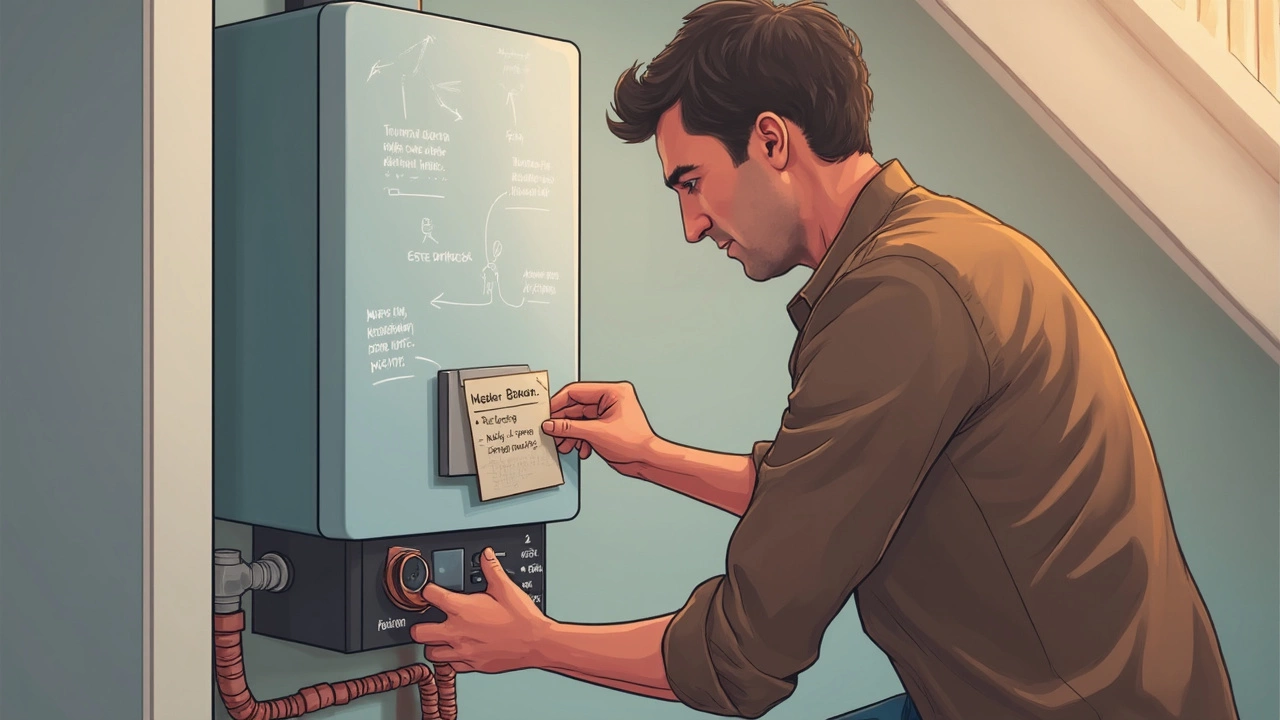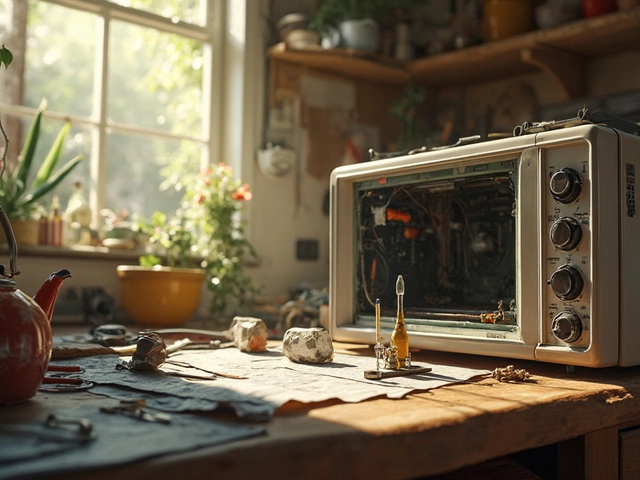No hot water when you turn on the tap? That’s usually the first clue something’s up with your water heater, and it might just need a reset. This doesn’t mean your heater is done for—sometimes it’s just a safety feature kicking in because of a simple glitch or power issue.
Look around the tank for a small red or black button. That’s the reset button, also called the “energy cut-off switch.” If this pops, your heater won’t heat water until you reset it. Most people don’t even know this button exists until there’s a problem. It’s there to stop the heater from getting too hot, keeping things safe.
Before you start poking around, though, pay attention to any weird noises, leaks, or if the heater is tripping the breaker. These aren’t reset issues—they might mean something bigger is going on. If everything looks normal except for the cold water, you’re probably in the clear to try a reset. Careful, though—always turn off the power to the heater before opening panels or touching wires. Safety first, no shortcuts.
- Common Signs Your Water Heater Needs Reset
- Why Water Heaters Trip—And What It Means
- How to Safely Reset Your Water Heater
- When to Call a Pro Instead
Common Signs Your Water Heater Needs Reset
If the shower suddenly turns freezing and you’ve got no hot water anywhere in the house, your water heater might just need a reset. This problem hits fast—one day everything’s working, next thing you know, you’re shivering first thing in the morning.
Here’s what usually tells you the reset button has popped:
- No hot water at all, anywhere in the house. This one’s the big red flag for a reset issue.
- The unit’s reset button is sticking out or lit up. Most water heaters have a little red or black reset button, usually behind the upper access panel, and it'll either pop out or turn a different color if it needs to be pressed.
- Your circuit breaker tripped at the same time your hot water stopped working. Sometimes, when the water heater has a problem, it'll flip the breaker for good measure.
- A sudden electrical storm or a quick power outage before the problem started. It’s actually common for power blips to trip the reset as a safety move.
- The water is cold or lukewarm all day, even after giving the tank plenty of time to recover.
Some folks notice a faint ‘click’ from the heater before the hot water disappears. You might also spot that your water heater sounds quieter than usual – no humming, hissing, or normal operation sounds.
If you want to get nerdy, data from 2024 home surveys show that around 60% of sudden hot water losses in electric tank-style units are fixed with a simple reset—no expensive repairs, no calls to the plumber.
| Sign | What It Means |
|---|---|
| No hot water (all taps) | Possible tripped reset switch |
| Reset button popped out | Heater overheated or safety triggered |
| Breaker tripped | Heater drew too much power |
| After a power surge | Safety feature responded to electrical change |
If just one faucet is cold or the water’s only briefly warm, the problem may not be the reset button but something like a faulty element or valve. If all taps are stone-cold, though, that’s when you start thinking about hitting the reset button.
Why Water Heaters Trip—And What It Means
The reset button on your water heater doesn’t just trip by accident. It’s basically a safety backup to shut things down if the water temperature gets out of control. So if you notice the reset tripping, your heater is trying to tell you something’s not right.
Here’s why this happens most often:
- Thermostat Malfunction: Electric water heaters usually have two thermostats—one at the top and one at the bottom. If one of these goes bad, it can fail to read the right temperature, making the heater run non-stop until the safety switch trips.
- Heating Element Failure: A busted heating element can short out or keep running, causing the water to get way too hot. That’s a common reason for the reset button popping out.
- Wiring Issues: Loose or damaged wires, sometimes from old age or quick DIY fixes, can cause electrical shorts. Not only can this trip the reset, but it can be a serious fire risk too.
- Tripped Circuit Breaker: If you notice your breaker flipping off along with the water heater, it’s usually a sign of too much load or faulty parts. Don’t ignore this—electrical problems are nothing to mess with.
- High Temperature: Water heaters usually keep water between 120°F and 140°F. If yours pushes past 180°F, most reset switches will trip right away. Bacteria like Legionella can also grow in lukewarm water, which is why heaters are set hot—but there’s a fine line between safe and scalding.
- Age and Sediment Build-up: Over time, minerals in hard water settle at the bottom of the tank. This sediment layer makes your water heater work way too hard, and eventually, things can overheat and trip the reset. If you haven’t flushed your tank in a year, add that to your to-do list.
Here’s a quick rundown of why heaters might trip and some estimated impact:
| Cause | How Often It Happens (%) | What It Means |
|---|---|---|
| Bad Thermostat | 35% | Needs replacement, unit keeps overheating |
| Heating Element Failure | 30% | Replace element, resets keep tripping |
| Electrical Issues | 20% | Loose wires or breaker problems |
| Sediment Buildup | 10% | Flush tank, improve water quality |
| Other (like power surges) | 5% | Rare, but can still trip safety |
A water heater repair tech rarely finds a tripped reset that isn’t tied back to one of these. If your water heater keeps needing resets, don’t just keep pushing the button—figure out why. Fixing the root problem early avoids bigger repairs (and surprise icy showers) down the line.

How to Safely Reset Your Water Heater
Resetting your water heater can be quick, but skipping safety steps risks a shock or worse. If you’re using an electric model, double-check that the power’s completely off before touching anything. For gas heaters, stick to the reset process in the manual—messing with anything else can get dangerous.
Here’s a safe, step-by-step way to reset an electric water heater:
- Turn off the power. Find your breaker box and switch off the circuit for the water heater. Never skip this step or just rely on flipping the unit’s switch—wiring inside can still be live.
- Open the metal panel. Most heaters have a small metal plate screwed over the thermostat and reset button. Grab a screwdriver, remove the screws, and pull away any insulation to see the reset button.
- Press the reset button. It’s usually red and round, and might be labeled “reset.” Push it in until you feel or hear a small click. If it immediately pops back out, stop here—there’s probably a deeper issue like a failing thermostat or heating element.
- Reassemble the panel. Put the insulation and cover back like you found it, making sure it all fits snug and tight.
- Restore power. Flip the breaker back on. Now comes the waiting game—it can take up to an hour for water to heat up fully, especially if the tank cooled down completely.
Check your hot tap after 30-60 minutes. Still cold? If you already tried resetting once and it didn’t stick, the water heater might need real repairs. Don’t keep pushing the button over and over—it’s not a magic fix and could make the problem worse.
Here’s a quick rundown of how long it usually takes to get hot water again after a reset:
| Tank Size (gallons) | Full Reheat Time (minutes) |
|---|---|
| 30 | 35-40 |
| 40 | 50-60 |
| 50 | 70-80 |
Reset tips: If your reset button keeps tripping, it’s usually a sign of an issue like a broken thermostat, stuck heating element, or wiring problem. Don’t ignore it or keep resetting—call a pro. Gas water heaters don’t generally have this reset button—if you’ve lost hot water with a gas model, try relighting the pilot or check for error codes on smart models.
When to Call a Pro Instead
Sometimes, hitting the reset button just isn't enough. Certain issues with your water heater need a professional. Messing with electricity, gas, or water lines without the right skills can be risky—and even dangerous.
If you spot these signs, it’s time to call in a pro:
- The reset button keeps tripping over and over, or won’t stay in
- You hear popping, banging, or hissing noises coming from the tank
- You see water pooling around your heater, rusty water from the taps, or notice a rotten egg smell (could mean a gas leak or bacteria problem)
- The breaker trips every time the heater runs, or there’s visible scorching by electrical parts
- Parts or wires look burnt, melted, or there’s a strong burning smell
- You’re not comfortable or confident opening panels or dealing with wires
It’s better to get help than risk making things worse. Licensed technicians can spot problems you might miss—like a failing thermostat, a broken heating element, or hidden leaks. If your tank is over 10 years old and you’re running into problems more often, pros will also know if it’s time for a replacement rather than a quick water heater repair.
According to a 2024 HomeAdvisor report, the average cost for basic water heater repairs is $220, but a replacement can run over $1,500. Ignoring small issues can turn that $220 job into a new water heater bill sooner than you think.
| Problem | DIY? | Call a Pro? |
|---|---|---|
| No hot water, reset button popped once | Yes | No |
| Reset button keeps popping | No | Yes |
| Water leak or rust | No | Yes |
| Signs of electrical/gas damage | No | Yes |
The bottom line: use your head and don’t take gambles with safety. If you’re in doubt, or the fix isn’t obvious, grab the phone and call an expert. It’s worth the peace of mind.





